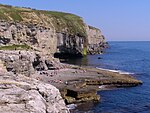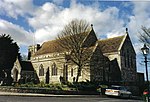Halsewell (East Indiaman)

The Halsewell was an East Indiaman that was wrecked on 6 January 1786 at the start of a voyage from London to Madras. She lost her masts in a violent storm in the English Channel, and was driven onto the rocks below a cliff on the Isle of Purbeck in Dorset, England. The vicar of nearby Worth Matravers recorded the event in his parish register: On the 4th, 5th and 6th day of January, a remarkable snow storm, sometimes a hurricane, with the wind at south. On the latter day, at two in the morning, the Halsewell East Indiaman, 758-tons burthen, commanded by Captain Richard Pierce, bound for Bengal, was lost in the rocks between Seacombe and Winspit quarries in this parish. Never did happen so complete a wreck. The ship long before day-break was shattered to pieces... Of over 240 crew and passengers, only 74 survived. The shipwreck shocked the nation. The King visited the scene of the tragedy. The wreck of the Halsewell was the subject of poems, paintings and an orchestral symphony. Many years later Charles Dickens described the wreck in a short story.
Excerpt from the Wikipedia article Halsewell (East Indiaman) (License: CC BY-SA 3.0, Authors, Images).Halsewell (East Indiaman)
Priest's Way,
Geographical coordinates (GPS) Address Nearby Places Show on map
Geographical coordinates (GPS)
| Latitude | Longitude |
|---|---|
| N 50.589204 ° | E -2.020572 ° |
Address
Priest's Way
BH19 3LB
England, United Kingdom
Open on Google Maps







